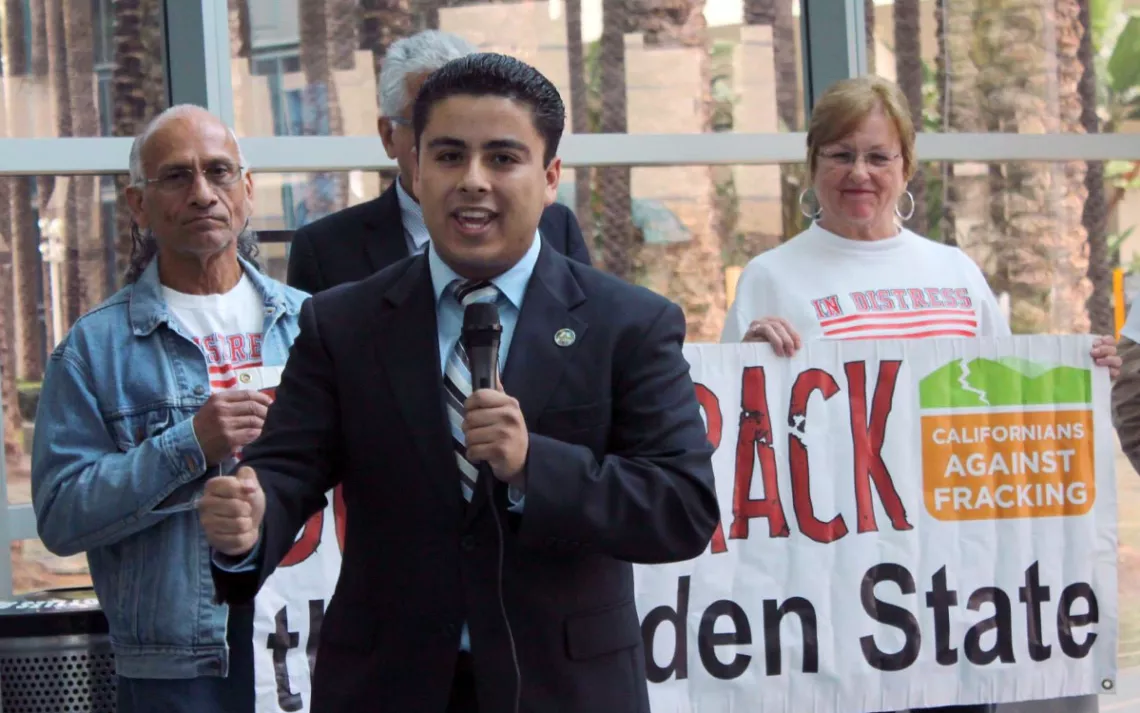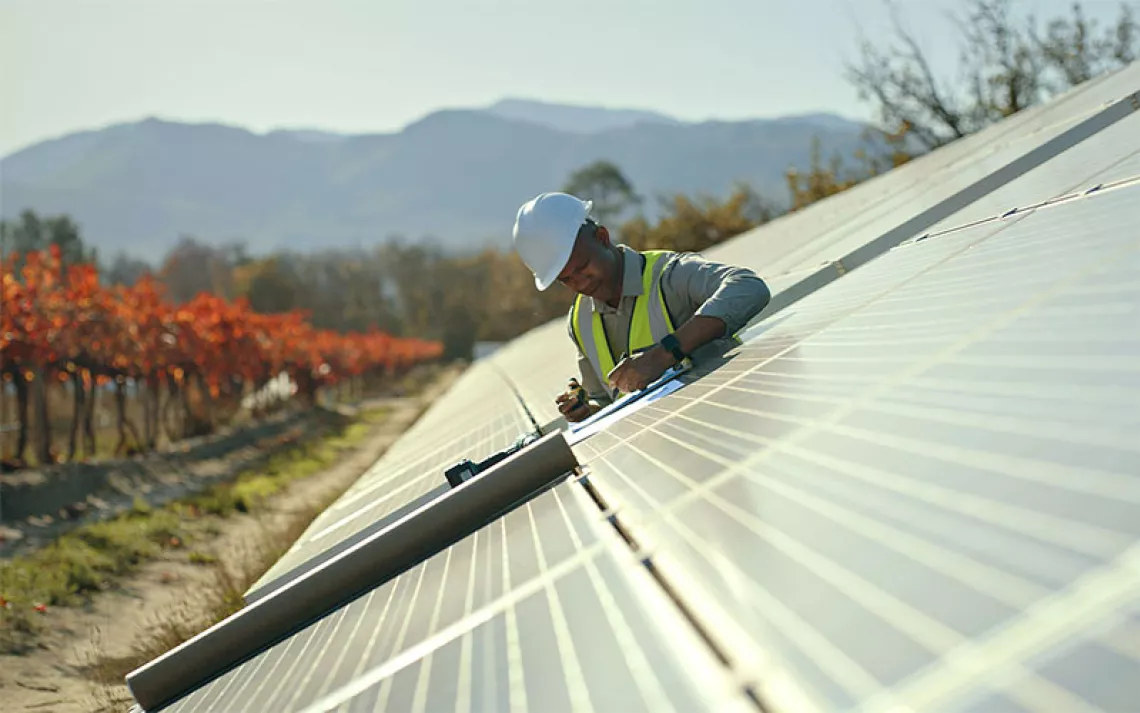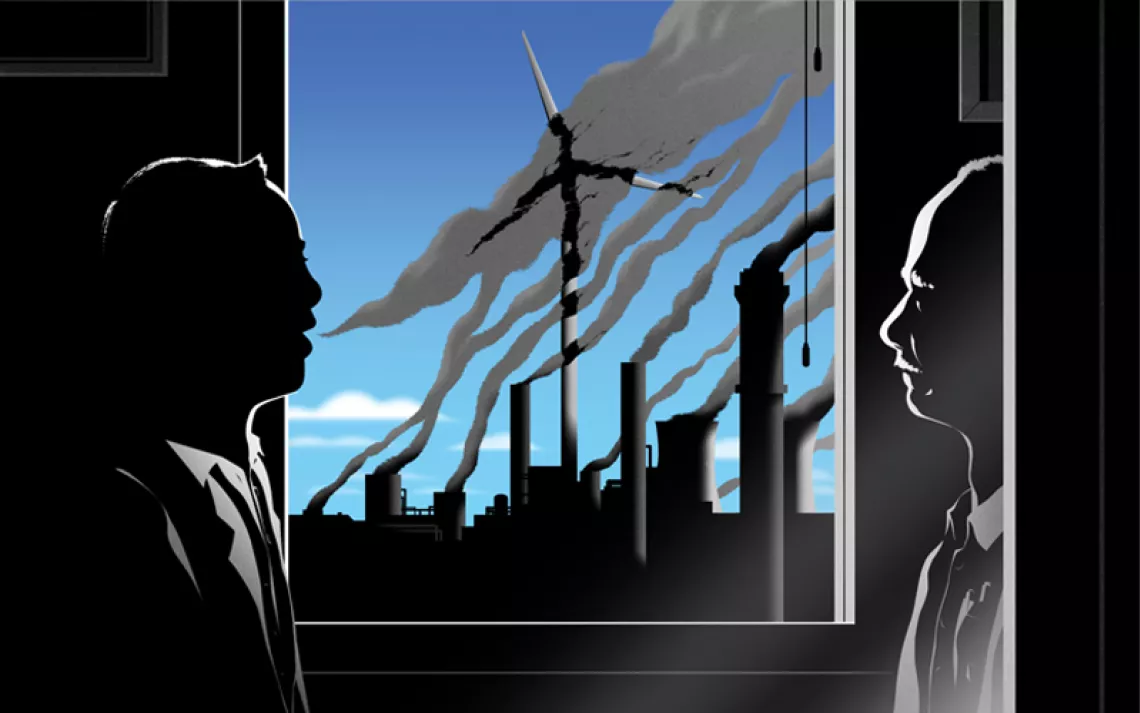Pollution Makes the Personal Political
How an asthma epidemic turned one town against Big Oil

Jose Gurrola at the 2014 Democratic Party CA State Convention | Photo courtesy of Jose Gurrola
Jose Gurrola always keeps an inhaler nearby—tucked into his gym bag, in his car, in his office. He’s had asthma for as long as he can remember. He considers himself lucky because he was diagnosed early; his mother is a nurse.
After his diagnosis, his parents pulled up all the carpet in their house in Arvin, California, since carpet fibers can harbor the pollutants and allergens that trigger asthma attacks. But it was clear that the problem was larger than the Gurrola household. “In this city,” Gurrola explains, “if you ask people to raise their hand if they have struggled with asthma, almost every hand goes up.”
The first text after the banner on the Arvin Union School District website is not about recent events or student accomplishments or policy changes, but rather reads Arvin Air Quality Data. “We experience more leaks and more fumes and more headaches than the rest of the county, but we don’t get the money or the engineering jobs,” says Salvador Partida of Committee for a Better Arvin. “Why should our kids be put at risk and need inhalers every day?”
Asthma is an inflammatory disease. Think of something like an acid burn, says pulmonologist and asthma expert Charlie McDonald, but on the soft tissues of the airway. Slowly, this inflammation inflicts cumulative damage, eventually developing into a permanent condition.
One of the biggest problems experienced by asthmatics, says McDonald, is the routine underestimation of their struggle. “It takes energy not being able to breathe.”
For a child without asthma, about 3 percent of the body’s energy is devoted to the simple act of breathing. For a child with asthma and experiencing symptoms, that number climbs up to 10 to 15 percent. If the asthma is not regularly managed, teachers may begin to understand that the child’s shortened attention span and sluggishness are just normal ways for the kid to be. Diagnosing children can be difficult—they simply see themselves as regular kids and don’t want to complain.
Asthma is just one of the most visible signs of bad air. Exposure to air pollution—and particularly particulate matter pollution—can interfere with placental development. This hinders the delivery of nutrients and oxygen, slowing the baby’s development. It can also cause inflammation in the womb, causing early contractions and birth. According to the California Environmental Health Tracking Program, preterm births attributable just to particulate matter pollution cost Kern County over $45 million annually. These costs are borne by families in an area where 45 percent of residents are on Medi-Cal and 9 percent (conservatively estimated) are uninsured altogether.
The more he learned, the more Gurrola realized that the air quality in his hometown was not what it should be. At the age of 19, he ran for city council and won. He wanted a lot of things for Arvin, but more than anything, he wanted to clean up the air.
He soon learned just how difficult this could be.
Complex local context
The first day I met with Gurrola, it was 104°F, the type of heat that coats you in a fine layer of sweat in the time it takes to walk from your car to the edge of the parking lot. It was hard to see the mountain skyline through the smog in the air, but the city hall’s lawn was well-manicured, a splash of bright flowers fighting against the drab, 60s-era tan tiling of the building. Inside, the air-conditioner blasted a small waiting room, and the tables were stacked with voter registration information and informational pamphlets on topics like immigration services and taxes, in English and Spanish.
Elsewhere in Kern County, there’s a tendency to blame the polluted skies on the Bay Area, Los Angeles, or even China—as the story goes, the wind carries pollution from these cities to Arvin, where it gets trapped over the city by the mountains. Arvin's former mayor, Jose Flores, told Valley Public Radio that Arvin’s pollution is “inherited.”
There’s some truth to this. Even in the Central Valley, which already contains five of the EPA’s 10 worst cities for air quality, the 19,000 residents of Arvin are situated in one of the most geographically unfavorable locations. The city is squeezed between large dairy farms and nut orchards, oil fields, and major highways, and backed up against the mountains of the Tehachapi Pass.
But according to the San Joaquin Valley Air Pollution Control District, only 7 percent of pollution in Arvin is “transported” from outside of the southern region of the valley. The rest is home-grown. Seven of the top 10 taxpayers in Kern County are oil and gas companies. The industry supports thousands of jobs—the majority of them concentrated in the larger, wealthier, and more conservative Bakersfield.
Smog is primarily created by two components: volatile organic compounds (VOCs) and nitrous oxides (NOx). Among VOCs in the greater San Joaquin Valley—an area including Kern and several other counties—the air pollution district reports that the largest stationary sources are agriculture (31 percent of emissions) and oil production (7 percent) with mobile sources (cars, trucks, and other vehicles) contributing another 21 percent. Of the nitrous oxides, over 60 percent comes from mobile sources like cars and trucks, with farm equipment making up the next largest blocks at 17 percent and 10 percent.
The oil industry also contributes pollutants. Stanford energy resources engineering professor Adam Brandt, who has studied oil production in the Central Valley, found that oil and gas operations in the San Joaquin Valley are responsible for 31 percent of sulfur oxides and 70 percent of hydrogen sulfide in the area. Sulfur oxides can contribute to smog and directly harm the respiratory system and trigger asthma attacks. Hydrogen sulfide can also trigger asthmatic symptoms as well as nausea and vomiting.
“The rest of the county likes to blame San Francisco or China or whoever they can,” says Gurrola, “but in Arvin we see oil operations and we see the agriculture and we experience the impacts of these industries. So no, we can’t blame other places.”
The teenage councilman
A few months after Gurrola was sworn in to the city council, Southern California Gas detected signs of a leak near Arvin High School, in Gurrola's neighborhood. As it turned out, the leak was from a line owned by Petro Capital Resources, used not to deliver gas to homes, but instead to flare off excess gas in oil field operations.
For two years before the leak was discovered, some families living near the pipeline had complained about smelling gas, as well as headaches, nausea, random and persistent nose bleeds.When the leak was officially detected, the levels of gas measured were high enough to pose a substantial risk of explosion.
After the leak was detected, the pipeline operator spent four days locating the leak. The three-inch pipe was too small to require regular safety inspections under California regulations, but was nevertheless capable of leaking enough crude, unrefined gas—completely invisible to the human eye—to force the evacuation of dozens of families for eight months.
In the wake of the Petro Capital leak, Gurrola proposed a complete moratorium on oil and gas operations in Arvin. He thought that with the leak, the rest of the city council might be willing to put the brakes on development. But then the Kern County Board of Supervisors sent in representatives to lobby the Arvin City Council.
The supervisors told Gurrola and the rest of the city council to hold off on taking action. The county was creating an ordinance that would complete an environmental impact report for all future oil and gas development, they said, one that would provide protection from future leaks. Instead, says Gurrola, the completed county ordinance (itself still being challenged in the courts) allows the drilling of up to 70,000 new oil wells in the county over the next two decades. The city council’s vote on the oil and gas moratorium failed to pass.
“Bakersfield and the county government get a lot of money from the oil industry,” says Gurrola. “So they sent people in and made sure there was no moratorium.”
In the months after the leak, Arvin residents filed 416 legal complaints against the county and the city, seeking a total of over $10 million in damages. At the conclusion of these arguments in 2016, two years later, Petro Capital Resources would only be fined $75,000.
Stopping the damage
While Gurrola was on city council, he continued taking classes at Cal State Bakersfield. School, he said, made him a better policymaker, forcing him to think deeply about economics at one point and law at another. “I just try to soak it all up like a sponge,” he said.
When Gurrola graduated, his parents suggested that he move on to the next step of his career and leave Arvin to attend law school. He was 23 by then and nearing the end of his term on city council. Instead Gurrola decided to run for mayor.
Gurrola’s campaign was grassroots, focusing on environmental issues as well as immigration. He knocked on doors, utilized his connections from years of work with the Boys and Girls Club. He met with community groups and stood by bold, progressive policies like sanctuary cities and ideas for community renewable energy entities. He gained the attention and endorsement of the famous farmworker rights and environmental justice activist Dolores Huerta. He painted a vision of Arvin as a player in Kern County’s energy-rich tradition by joining in the burgeoning solar industry. An Arvin with a college-educated workforce and available, high-paying jobs. An Arvin with green-filled parks and electric, emissions-free buses. He won the election.
As mayor, he returned to fighting the oil industry, but with a more nuanced strategy than the complete oil and gas moratorium he had proposed as councilmember. It was also a strategy, Gurrola acknowledged, that fit more clearly within the scope of his powers under state law. This time, Arvin would protect itself by updating its oil and gas ordinance.
“The current oil and gas ordinance that is on the books in Arvin hasn’t been updated since before the moon landing,” Gurrola said. “It can be printed on two sheets of paper and requires less insurance coverage on oil operations within the city than most of us carry on our cars. The permit application is only $5.”
Gurrola’s main change to the ordinance created a 300-foot buffer zone between future oil and gas operations and heavily populated areas like schools and hospitals. It included stricter rules for operators in terms of noise and odor control.
The proposed changes caught the attention of supporters and opponents alike. Environmentalists and Arvin residents called him authentic, dedicated, and politically savvy. Groups like the Western States Petroleum Association called his environmental agenda naive and fiscally damaging. A trustee of the Kern High School District went so far as to say that the plan was “schizophrenic” and would take away jobs.
The city council passed the updated ordinance on July 17. The regulations can’t keep out air pollution drifting over from elsewhere in Kern County—if Gurrola had his way, he says, there wouldn’t be any oil and gas operations in the area. As it is, some of the environmental groups he’s worked with such as the Center on Race, Poverty, and the Environment don’t think the ordinance went far enough. But, he says, “I think we all understand this is the best we can do right now.”
Some days, Gurrola fills in as a substitute teacher before heading to City Hall for the afternoon and evening—in Arvin, the mayor also sits on city council, which meets in the evenings. On the days Gurrola subs, he is given a list of the students’ health conditions. Asthma tops the list every time.
According to Gurrola, while many of the kids have their own inhalers, those who are undiagnosed or without health care go without. There’s something deeply disconcerting about this normalization, how the members of a society with the least control over their circumstances and the least contribution to harmful environmental realities around them suffer the most severely from these contaminants.
From Gurrola’s perspective, “These are my constituents too, even if they aren’t voting. I think that’s forgotten all too often by elected officials."
Toward a different future
On the drive from Bakersfield to Arvin, there’s a quiet road called Comanche. The traffic down this two-lane road is mostly farming equipment and semi-trucks. One side of the road presents alternating patches of row crops and slowly bobbing oil derricks. On the other side, rows of shimmering black solar panels stretch back from behind the industrial fencing and fade into the landscape. Drive another half hour southeast into the mountains and the sleek white blades of wind turbines take over the sky.
If you drive in the mountains near Arvin, you’ll see solar panels in the valleys all around you. Gurrola remembers first really noticing them in middle school, then watching them proliferate quickly in the last decade. The large, industrial solar farms—which produce electricity bought by Kern and areas like L.A. and the Bay Area alike—can look like a glistening desert oasis. Colloquially, this has become known as the lake effect. The resemblance is so strong that migratory water birds have actually been observed attempting to land amidst the panels, mistaking them for an aqueous resting place.
David Teasdale, the director of the 21st Century Energy Center in the Kern Community College District, says that the clean energy training program’s first funding came from the Obama administration’s 2008 federal stimulus. When that money ran out, the program had picked up enough traction to keep going. And while Bakersfield residents still account for the most enrollees, thanks to the city’s size and close proximity to the main campus, Arvin comes in at a close second by enrollee numbers. One of Gurrola’s main goals is to bring a satellite campus of the community college to Arvin. He views the formal unveiling of plans for the new campus, due to open in fall of 2021, as one of his crowning achievements so far as mayor.
If you drive far enough south down the I-5 freeway from San Francisco through the Central Valley, at some point you will blink to refresh your eyes in the blurry dullness of the drive, and when your vision returns just a moment later, you will find that a sepia lens has taken over. It colors the ground; it’s in the air. But even within that lens, you still might spot the oasis if you look hard enough.
The city council passed Gurrola’s new ordinance in mid-July. And once again, it seemed like outsiders had to take just a little more notice. The Bakersfield Californian noted fear among the oil and gas industry that the ordinance might represent a dangerous precedent and a change in the tide of local public opinion. In Sacramento, California attorney general Xavier Becerra went so far as to call the ordinance a “momentous public health victory.”
“For far too long, Arvin . . . has had to bear significant pollution burdens,” Becerra said. “That unfortunate reality will begin to change.”
For Gurrola, he’ll be focusing on implementation of the ordinance—and keeping up with his law school classes. After that, he’ll continue toward his dream of an Arvin powered by 100 percent clean energy. “Fighting for clean air and clean water isn’t just a talking point because Democrats support it,” Gurrola says. “It’s a position that I have because of my lived experience. No one had to tell me about these things. I’ve lived with this poor air and still do.”
 The Magazine of The Sierra Club
The Magazine of The Sierra Club







